20 games to get active at home for children with Down syndrome

20 fun activities for the home
- Obstacle course options a brilliant way to get your child moving at home. You want to set it up to get your child to move in as many different ways as possible. This Our Home video shares lots of ideas of setting up a course.
2. Use furniture to make your course – setting it up with the help of your child is a lovely way to get them active as they will need to carry and move furniture and objects with you.
3. Once your obstacle course is set up, you can also add some extra stages and mark them with a piece of paper or some tape. For example, one section might need to be done hopping on the spot, another spinning, and another doing long jumps.
4. You can also suggest your child negotiates the obstacles in different ways, perhaps backwards or in the style of their favourite animal.
5. As the obstacle course becomes a more established activity in your home, encourage your child to create new obstacles themselves. This is a great way to test their imagination and engineering skills.
6. You could also create fun themes for your obstacle courses, like pirates, beach, jungle, castles or one of your child’s special interests.
You can also set up an obstacle path in your home, using painters tape to mark out the route. Watch this video for ideas.
You can put the course in a corridor, for the whole family to complete every time they go through the corridor.
You can also make an obstacle path on a patio or pavement using chalk.
Building a den is good way to get your child moving without them necessarily noticing. The process of building a den – moving furniture, lifting cushions, fetching blankets – is surprisingly active!
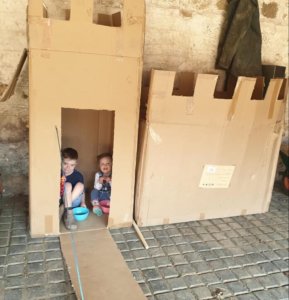
Making a den has the added bonus of creating a new space to play in. It can provide your child with a dark, quiet area to retreat to when they need a sensory break.
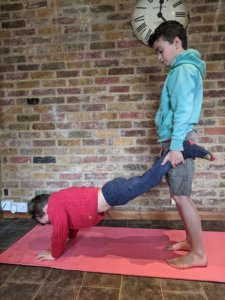 Wheelbarrow walking is incredibly challenging but brilliant for our children and can also be great fun. Not only does it strengthen the core but it is also brilliant for shoulder and arm stability – essential for good fine motor skills – which can be problematic for children with DS. As it is so challenging, try to give more support rather than moving down this sequence too quickly as they may give up too quickly if it is far too hard for them.
Wheelbarrow walking is incredibly challenging but brilliant for our children and can also be great fun. Not only does it strengthen the core but it is also brilliant for shoulder and arm stability – essential for good fine motor skills – which can be problematic for children with DS. As it is so challenging, try to give more support rather than moving down this sequence too quickly as they may give up too quickly if it is far too hard for them.
Hold your child by their hips with their legs straddling you and their hands on the floor. Move around the floor picking up objects for as far as you can go.
Move your hands down to your child’s knees and walk around the room – picking up objects or playing a matching game or skittles.
If you can, hold your child by their ankles. Make sure they keep their bottom in the air and don’t hang their tummy down. Again find a game to make this more entertaining.
As your child gets stronger you could try to get from one end of the house to another – even trying going up the stairs.
You could also make an obstacle course to go around.
If there are other siblings, wheelbarrow races can be great fun for all the family.
This game needs some concentration but can be a brilliant challenge for our children.
Set up a balance board on a table or on the floor with a board and a bottle or rolling pin.
See this ‘Our Home’ video for an explanation of how to play this great hand balance game.
Painters tape works well for tape games as it doesn’t leave a mark when you remove it and is colourful.
You can use tape to make targets on the wall or floor for our children to throw balls or other objects to score points or goals.
This video gives lots of other ideas of games to play with tape.
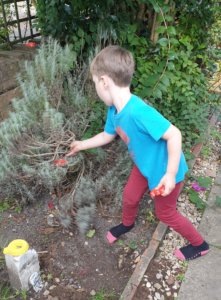 Take photos of objects around your home using your tablet or phone.
Take photos of objects around your home using your tablet or phone. - Your child then needs to find each object around the house. See this ‘Our Home’ video as an example of the game in action).
- You could also hide objects around the house for the child to find.
This is a great copy game. One person does an action and the other person has to copy them.
This is a great way to convince your child to do any action you want from them!
Alternatively ask them to lead the game and see where their imagination takes you.
This game can provide hours of fun. One person can hide around the home while the other counts out loud to 10 and then has to go around the home to find them.
Take turns in hiding and finding.
If your home isn’t very big, you could adapt this to hiding an object for them to find – e.g. a sock or stuffed animal.
You may want to start this game just in one room until they understand the game.
You need at least three people for this game. If you don’t have a parachute at home then a sheet will do the same job.
Hold onto the edges of the parachute/sheet together.
Put objects in the middle and make the objects move around the sheet by lifting or lowering your arms.
Challenge your children to try and work out how to make the object jump as high in the air as possible or go around in a circle as quickly as possible.
Use a gym ball for a fun way to challenge your child’s balance.
When using a gym/physio ball, make sure you have complete control of the ball and your child to try this – it may take two adults. You can wedge the ball into the corner of the room to make it more stable until you are more confident in your handling.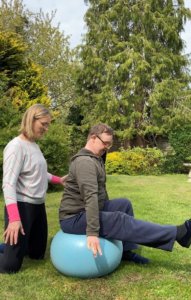
Hold your child at their hips so you have control of their bottom and the ball. Very slowly move the ball in all directions.
As they get more confident you can move in bigger movements but keep going very slowly to challenge them.
Hold the position at the extreme of where they can go to make it a little harder but have a second person ready to catch them if they fall.
See if they can balance themselves sat on the ball with feet on the floor. If they manage this, ask them to lift 1 leg to balance.
Ask them to lie back on the ball to pick up an object behind them and then make them sit up to give you the item.
Be careful if your child is impulsive and lacks a sense of danger as gym balls can be a recipe for disaster in the wrong hands!
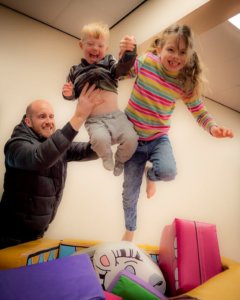 Jumping is a fabulous workout for children and is often difficult for our children with DS as it requires power and good knee strength and stability.
Jumping is a fabulous workout for children and is often difficult for our children with DS as it requires power and good knee strength and stability.Start on a bouncy surface to show them how. Encourage them to bend their knees between jumps. Your child can jump on the bed, off the sofa onto a pile of cushions (use a fitted sheet to help make sure the cushions won’t slip away as they bounce onto them) or just on the floor.
Try offering challenges – how many jumps can they do in a row? Can they jump forward or on the spot? Can they tuck their feet up as they jump and then land on their feet?
If you have a trampoline then these Trampoline Tutorials take you through the basic trampoline techniques in a very thorough and well described way. Trampolining can be dangerous so we advise nets around the trampoline and supervision.
- Dancing is a brilliant form of exercise. There are numerous YouTube channels with music to dance along to for younger kids. Older children will probably prefer pop music, or they may have their own favoured genre! Turn up the music and let your child dance however they want to.
2. Our ‘Music at Home‘ page shares ideas of YouTube channels to try. Find one song that your child especially likes. Help your child with the movements to start with and, over time, they may well anticipate the next movement and start to take over. This is a great way to get a daily workout into your child’s life.
3. This video from Flamingo chicks is the first in a series of inclusive dance videos which use Makaton and easy to follow steps to help your child to dance. They are each themed (this one is Space). Look out for more coming soon.
4. These videos from ‘Just Dance Kids’ demonstrate some dance routines for your children to follow along to nursery rhymes and other well known childhood songs.
Make a game of pretending to be different animals. Try being a snake on the floor, a jumping kangeroo, a bear walking on straight arms and legs or a crab moving sideways on hands and feet, tummy pointing up.
Make an obstacle course and challenge your child to complete it as different animals.
Put names of different animals into a hat. The person who draws a name has to pretend to be the animal they pull out, while the rest of the family has to guess what animal they are.
"Sports Day" Games
Make a game of pretending to be different animals. Try being a snake on the floor, a jumping kangeroo, a bear walking on straight arms and legs or a crab moving sideways on hands and feet, tummy pointing up.
Make an obstacle course and challenge your child to complete it as different animals.
Put names of different animals into a hat. The person who draws a name has to pretend to be the animal they pull out, while the rest of the family has to guess what animal they are.
Make a game of pretending to be different animals. Try being a snake on the floor, a jumping kangeroo, a bear walking on straight arms and legs or a crab moving sideways on hands and feet, tummy pointing up.
Make an obstacle course and challenge your child to complete it as different animals.
Put names of different animals into a hat. The person who draws a name has to pretend to be the animal they pull out, while the rest of the family has to guess what animal they are.
Balance a beanbag or flattish soft toy on your head.
Try to get from one end of the room to the other without it falling off.
Stand two children side by side their feet next to each other. If there isn’t another child available to take part, join in yourself. Be sure to remove your shoes to reduce the risk of stepping painfully on their feet!
Use a dressing gown cord to tie the participants ankles together. Make sure it feels comfortable. Then hold each other close and try to walk across the room together!
Line up several balls, socks or beanbags spaced about one meter apart. Place a bucket or laundry basket at the end of the line, again around a meter away.
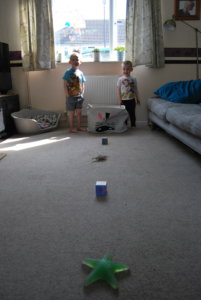
Now the run is prepared, ask your child to stand by the bucket.
Time to go! They should run to pick up the first ball/beanbag, run back and pop it in the bucket.
Next, they run to the second item, grab it, run back and put it in the bucket.
Repeat in turn until all items have been collected.
You can time how long it takes them to complete the bucket run to see if they can beat their record next time.
Use a combination of the sports day ideas above (and any others your think of) to make a great relay race around your home, each person taking their turn to complete a challenge.
Here are our suitable videos
Obstacle Course
Obstacle Path
Balance Board Games
Tape Games
Scavenger Hunt
Thank you for visiting Gympanzees’ website. All information provided by Gympanzees is of general nature and for educational / entertainment purposes. It is up to you as the parent or family member to judge what is appropriate and safe for your child. No information provided by Gympanzees should replace any professional information and advice that you have been given and speak to your therapist or doctor if you are unsure of anything. Should you use any of the information provided by Gympanzees, you do so at your own risk and hold Gympanzees harmless from any and all losses, liabilities, injuries or damages resulting from any and all claims.






